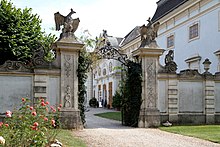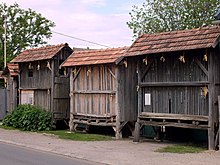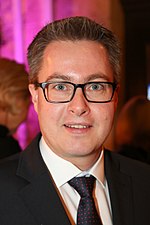Half turn
|
Half turn
|
||
|---|---|---|
| coat of arms | Austria map | |
|
|
||
| Basic data | ||
| Country: | Austria | |
| State : | Burgenland | |
| Political District : | Neusiedl am See | |
| License plate : | ND | |
| Surface: | 55.15 km² | |
| Coordinates : | 47 ° 52 ' N , 16 ° 58' E | |
| Residents : | 1,930 (January 1, 2020) | |
| Population density : | 35 inhabitants per km² | |
| Postal code : | 7131 | |
| Community code : | 1 07 08 | |
| NUTS region | AT112 | |
| UN / LOCODE | AT ALB | |
| Address of the municipal administration: |
Wiener Strasse 3 7131 Halbturn |
|
| Website: | ||
| politics | ||
| Mayor : | Markus Ulram ( ÖVP ) | |
|
Municipal Council : (2017) (21 members) |
||
| Location of Halbturn in the Neusiedl am See district | ||
 Halbturn Castle |
||
| Source: Municipal data from Statistics Austria | ||
Halbturn is a municipality with 1930 inhabitants (as of January 1, 2020) in Burgenland in the Neusiedl am See district in Austria . The Hungarian place name of the municipality is Féltorony .
geography
Halbturn ("Hoibtuan" in Burgenland) is located near the Hungarian border. Another district is Wittmannshof.
Neighboring communities
The neighboring towns in Austria are Frauenkirchen , Mönchhof , Nickelsdorf , St. Andrä am Zicksee and Andau , in Hungary Albertkázmérpuszta , Hegyeshalom and Mosonszolnok .
history
The area around Halbturn was already settled in Roman times. During archaeological excavations, a burial ground from the imperial era and a Roman villa were found. In 2008 , a team of archaeologists discovered an amulet from the 3rd century AD in the form of a gold scroll with the words of the Jewish prayer Shema 'Yisrael (Hear Israel! The Lord is our God, the Lord is one). It is considered to be the earliest surviving evidence of a Jewish presence in present-day Austria. The first documentary mention of Halbturn was in 1466, a document reports on a long-term border dispute between the convent of the Heiligenkreuz monastery , landlord in Mönchhof , and the Counts of Bazin, the owners of Halbturn, who wanted to expand their property. King Matthias Corvinus was asked to act as chief judge. The contending parties met at the feast of St. George. A commissioner of the king awarded the land and vineyards to the Heiligenkreuz Abbey on the spot.
Halbturn is mentioned by name for the first time in the document from 1466, but the place was probably founded earlier. Nothing is known about the appearance, size, residents, etc. of the "old, first half-turn".
Further documentary mentions are 1487/88 "villa Felthorom, Felthoron" and 1493 "poss. Holbenthurm ".
The name Halbturn is probably derived from a half-ruined tower of an old fort. This half tower is shown in the “Mönchhofer Hotterbüchl”. Whether the draftsman only drew this tower to better explain the area or whether it actually existed has not yet been clarified. However, the tower could have served to defend the important crossroads from Neusiedl to Altenburg (Magyaróvár) and from Ödenburg (Sopron) to Preßburg (Bratislava). The location of this tower could have been in the area of the castle and the floor plan of the third castle courtyard would also correspond to that of a tower. However, there is no pictorial or written evidence of this.
- Dominion and owner
Halbturn belonged to the Hungarian Altenburg (Magyaróvár) rule, which was then owned by the Counts of Bösing (Bazin) and St. Georgen (near Pressburg) and belonged to the Kingdom of Hungary. In 1516, after the family died out, the rule came back to the Hungarian crown as a direct Hungarian crown property. The Hungarian King Ludwig II gave the rule to his wife Maria (1505–1558), the sister of the Habsburg Ferdinand I, as a widow's estate. In 1526, after the death of Ludwig II, Maria took over her widow's residence and stayed in the county until 1528. After the conquest of Budapest by the Turks in 1540, the stud of the Hungarian queen widow Maria found a new home on the site of the destroyed Halbturn. King Ferdinand I allowed his courtier Eizinger to set up a stud on the Halbturner site. After the death of Mary, the property came back into the direct administration of the Habsburgs, since the Habsburgs took over their position when the Hungarian kings died out.
The place belonged, like the whole of Burgenland, to Hungary (German-West Hungary) until 1920/21 . Since 1898 had due to the Magyarization of the government in Budapest of Hungarian name Féltorony be used.
Historical maps
- Halbthurn / Fel-Torony and its surroundings around 1873 (recording sheets of the regional survey )
Population development

Culture and sights
- Halbturn : Baroque palace complex, from 1701 to 1711 by Johann Lucas von Hildebrandt built later by the court architect Franz Anton Hillebrandt reconstructed, and Franz Anton Maulbertsch with frescoes provided. Originally as a hunting lodge for Emperor Charles VI. built. Events such as exhibitions and the Halbturn Castle Concerts take place regularly in the castle .
- Catholic parish church in Halbturn
Regular events
- The Halbturner Palace Concerts have been held annually on Saturdays in July and August since 1973.
Economy and Infrastructure
The Andau / Halbturn wind farm is currently being built in Halbturn and the neighboring municipality of Andau . After the building permit was granted in 2010, the wind farm with a total of 79 wind turbines has been under construction since May 2012.
By half-turn of the leads of Frauenkirchen coming and to involvement in the Way of St. James Austria in Haslau-Maria Ellend predominantly in Burgenland running St. James Burgenland . The Way of St. James in Hungary is linked to the Burgenland Way of St. James in Halbturn.
politics
Municipal council
The council comprises a total of 21 members on the basis of population.
| Political party | 2017 | 2012 | 2007 | 2002 | 1997 | ||||||||||
|---|---|---|---|---|---|---|---|---|---|---|---|---|---|---|---|
| Sti. | % | M. | Sti. | % | M. | Sti. | % | M. | Sti. | % | M. | Sti. | % | M. | |
| ÖVP | 850 | 63.72 | 14th | 698 | 52.13 | 11 | 637 | 46.60 | 10 | 566 | 40.72 | 9 | 460 | 34.80 | 7th |
| SPÖ | 333 | 24.96 | 5 | 489 | 36.52 | 8th | 427 | 31.24 | 7th | 373 | 26.83 | 5 | 287 | 21.71 | 4th |
| FPÖ | 151 | 11.32 | 2 | 152 | 11.35 | 2 | not running | 451 | 32.45 | 7th | 575 | 43.49 | 10 | ||
| BLH | not running | not running | 303 | 22.17 | 4th | not running | not running | ||||||||
| Eligible voters | 1709 | 1751 | 1747 | 1681 | 1615 | ||||||||||
| voter turnout | 86.37% | 85.89% | 85.35% | 89.17% | 90.15% | ||||||||||
Parish council
In addition to Mayor Markus Ulram (ÖVP) and Deputy Mayor Paul Brunner (ÖVP), the municipal board also includes the executive councilors Friedrich Heider (SPÖ), Anita Rongitsch (ÖVP), Gerald Knöbl (ÖVP), Josef Thury (ÖVP) and Roland Ziniel (SPÖ) ) to the community council.
mayor
Mayor is Markus Ulram (ÖVP), who succeeded Peter Nachtnebel (ÖVP) in 2011.
Deputy Mayor is Paul Brunner (ÖVP).
Head of office is Johanna Knöbl.
Personalities
- Karl Ratzenböck (1878–1946), farmer and politician
- Franz Thury (1909–1988), state official and politician
- József Grősz (1887–1961), Roman Catholic Archbishop of Kalocsa in Hungary
literature
- Herbert Brettl: Halbturn through the ages . Halbturn municipality, Halbturn 1999
- Marietheres Waldbott: Half-turn . Roetzer, Eisenstadt 1975
- Section “The partner communities” in “TÜPL Bruckneudorf - 150 years of Brucker Lager” by Petra Weiß, publisher. Stadtgemeinde Bruck an der Leitha, April 2017, p. 432/433
Web links
- 10708 - half turn. Community data, Statistics Austria .
Individual evidence
- ↑ Falko Daim , Nives Doneus (ed.): Halbturn: The imperial burial ground and the villa of Halbturn, Burgenland: Natural space requirements, prospection and preliminary report (= monographs on early history and medieval archeology. Volume 10). Innsbruck 2004, ISBN 3-7030-0391-X .
- ↑ Nives Doneus (ed.): The imperial burial ground of Halbturn, Burgenland (= monographs of the Roman-Germanic Central Museum. Volume 122). 4 volumes, Römisch-Germanisches Zentralmuseum, Mainz 2014, ISBN 978-3-88467-233-4 ( online version ).
- ↑ a b Herbert Brettl: Halbturn through the ages. Halbturn municipality, Halbturn 1999
- ↑ Harald Prickler: The imperial stud in Mönchhof. In: Burgenland Life, 1977, 1/2
- ↑ Halbturn & Andau: 79 new wind turbines . In: ORF , May 4, 2012. Retrieved May 5, 2012.
- ↑ Province of Burgenland: Election results Halbturn 2017 (accessed on November 28, 2017)
- ↑ Province of Burgenland: Election results Halbturn 2012 (accessed on November 28, 2017)
- ↑ Province of Burgenland: Halbturn 2007 election results (accessed on November 28, 2017)
- ↑ a b Province of Burgenland: Halbturn 2002 election results (accessed on November 28, 2017)
- ↑ a b Municipality of Halbturn: Municipality Board and Councilors (accessed on November 28, 2017)
- ^ Municipality of Halbturn: Municipal office (accessed on November 28, 2017)
^ Archaeological sensation in Austria. Scientists from the University of Vienna unearth the earliest evidence of Jewish inhabitants in Austria, March 13, 2008, “Archived copy”. Archived from the original on March 30, 2012. Retrieved September 21, 2011.












